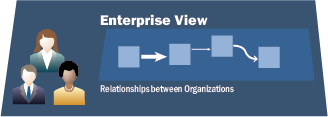Enterprise Viewpoint

The Enterprise Viewpoint considers the policies, funding incentives, working arrangements, and jurisdictional structure that support the technical layers of the architecture. It provides the basis for understanding who the implementers will be and the roles these implementers could take in implementing ITS. The Enterprise Viewpoint is also the source for objectives and goals for the surface transportation system. It also includes the policies and processes for architecture use to support transportation planning and project development.
A host of actors from the public sector and the private sector make up the Enterprise Viewpoint. Within the realm of public sector investment, the relationships between the actors have become rather established. This is in large part because ITS deployment decisions can be considered part-and parcel of the larger transportation investment decision-making process. This process has matured over the last 50 years of major infrastructure development (e.g., the interstate highway system). A cornerstone of this process is the strong legislative underpinning stemming from Title 23 of the United States Code (USC), the most recent reauthorization of which was the Safe Accountable Flexible Efficient Transportation Equity Act: A Legacy for Users (SAFETEA-LU). From the vantage of the private sector, both the automotive and communications industries have been major participants in developing various consumer products and services related to ITS. Various classes of actors participate in ITS deployment, operations and other aspects of the system lifecycle in reasonably well understood ways.
Stakeholders that take an acquisition, maintenance, installation, operations, certification, policy or user role will find many of their concerns addressed in the Enterprise Viewpoint. The Enterprise Viewpoint enables the stakeholder to answer questions such as:
- Who is responsible for providing transportation-related user services?
- Who is responsible for installation, operations and maintenance of ITS services, applications and devices?
- What relationships need to exist between transportation operators to facilitate services between and within jurisdictions?
- What relationships need to exist between the providers of services and the consumers of services?
The ARC-IT Enterprise Model defines the following objects:
- Enterprise Object: An organization or individual that interacts with other Enterprise Objects and/or physical objects. An Enterprise Object may be a component of another larger Enterprise Object, which may in turn be a component of a third, even larger, Enterprise Object. Enterprise Objects may participate wholly or in part in other Enterprise Objects (e.g., a Device Developer is a component of Auto Manufacturer but also participates in Standards Body).
- Resource: An asset that can support the achievement of enterprise objects. This may be a physical or virtual element and may be of limited availability. All physical objects are resources, but other resources may include policies and documents.
- Relationship: Formal or informal coordination between Enterprise Objects; e.g. agreements, contracts, funding, expectations.
- Role: The way in which an object participates in a relationship; an object's set of behaviors and actions associated with the relationship of that object with other objects.
The relationships between Enterprises and between Enterprises and Resources are largely determined by Roles (e.g., owns, operates, develops, etc.). In ARC-IT, Enterprises are named with the role explictly, so for example "Traffic Management Center Owner" is the enterprise that has the "owns" role with respect to the Traffic Management Center. This consolidation of Enterprise and Role is termed an Enterprise Object.
These two concepts: role and relationship, make up the bulk of the Enterprise View. Implicit with the assumption of a role is the assumption of Responsibility: an Enterprise that takes a role in a service probably bears some responsibility. While no responsibilities are defined in the Enterprise View, as of version 8.1 RAD-IT allows the planner to develop and assign responsibilities to stakeholders.
The following table shows the symbols used to represent elements of the Enterprise Viewpoint:
